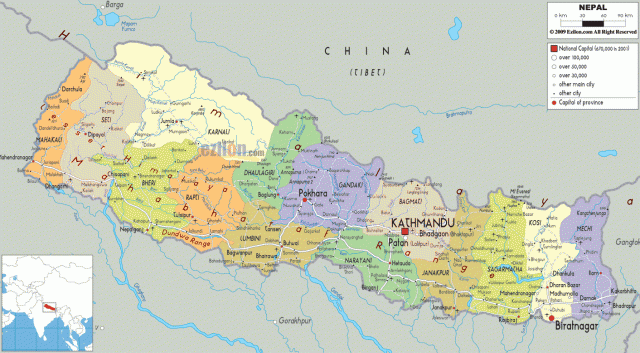Nepal
Area 87,489 square mi (140,800 square km)
Population 28.17 million 2014
Capital Katmandu
Highest Point 29,035 ft (8,850 m)
Lowest Point 230 ft (70 m)
GDP $19.64 billion 2014
Primary Natural Resources quartz, water, timber.
NEPAL, LOCATED between two Asian giants INDIA and CHINA, is a small country of approximately the size of the American state of FLORIDA. It extends some 500 mi (805 km) from east to west in an elongated rectangle along the arc of the HIMALAYAS.
The northeastern section of the country lies in the same latitude as northern Florida; the southeastern extremity, in the latitude of Fort Lauderdale; and Katmandu, the capital, in the latitude of Tampa. Its altitude varies from 197 to 722 ft (60 to 220 m) in the south to the highest mountains in the world in the north. Nepal is a land of great diversity. There are dense swampy jungles, rich rice-clad valleys, bleak alpine highlands, and towering snow peaks within a comparatively few miles of each other. The northern interior has bitterly cold winters, whereas the southern Terai, less than 100 mi (161 km) away, has a humid, subtropical climate year-around. Into this diverse physical setting many ethnic groups have immigrated over the years to give the nation a racial and cultural pattern as varied as the land itself.

Except for a narrow strip along its southern border, Nepal lies entirely within the great mass of the Himalayas. By altitude, Nepal is divided into three distinct zones: One, the Terai, consists of the low Siwalik or Churia range of Hills, Bhabar, and Terai along the southern border of Nepal; two, the central mountainous belt, varying in altitude from 1,000 to 8,000 ft (305 to 2,438 m); and three, the alpine zone, comprising the higher slopes and valleys of the main Himalayan range and the trans-Himalayan districts of Manangbhot, Mustangbhot, and Charkhabhot.
The backbone of the Nepalese Himalayas contains many of the highest mountains in the world; from east to west there are: Kangchenjunga (28,168 ft or 8,586 m); Makalu (27,790 ft or 8,481 m); Everest (29,035 ft or 8,850 m); Cho Oyu (26,750 ft or 8,153 m); Manaslu (26,658 ft or 8,125 m); Himali Chuli (25,801 ft or 7,864 m); the Annapurna I (26,391 ft or 8,091 m); Dhaulagiri (26,790 ft or 8,174 m); and, in the extreme west, Api (23,399 ft or 7,132 m).
These ranges divide the country into four distinct regions. The western region extends from the Sarda, or Mahakali River, to the Dhaulagiri range. The central region comprises the basin of the Gandak and its tributaries. The great southern offshoot from Gosainthan bifurcates to form the third region, the true Nepal, or valley of Katmandu, lying at an elevation of slightly more than 4,000 ft (1,219 m). To the east lies the fourth region, which is formed by the basin of the Sapt Kosi draining the mountain from Gosainthan to Kangchenjunga.
Rivers in Nepal flow mainly from north to south, which means they originate from the Himalayas and flow into the GANGES RIVER in India. The major rivers in the country of Nepal include the Mahakali, Karnali, Bahai, Rapti, Narayani, Bagmati, Kamala, Sapta Koshi, and Kankai.
In the early history of Nepal it is difficult to distinguish fact from legend. Many successive dynasties followed until King Man Deva, in the 5th century established trading links with India and Tibet and enriched the country. Little is known of the ancient kingdom of Gurkha, but tradition and legends say that the ruling family descended from the Rajput princes of Udaipur, India. After the conclusion of Anglo-Nepali War in 1815, the strong prime minister of Nepal, Bhim Sen, greatly increased the power of prime minister's office and paved the way for the establishment of the Rana line of hereditary prime ministers. From about 1850 to 1950, the hereditary prime ministers of the Rana family wielded supreme power under the aegis of titular kings. The Ranas were not progressive; they controlled great wealth, and continuance of their position seemed to rest upon an economically depressed Nepal.
As a result, a palace revolt occurred in 1950, when the king regained his position of authority, and in February 1951, King Tribhuvana's proclamation of a constitutional monarchy ended the reign of the 104-year-old Rana oligarchy. With a new constitution, which came into effect from 1959, many encouraging political developments took place in Nepal; however, economic depression still continues and currently Maoist rebels have taken a political path of armed rebellion.